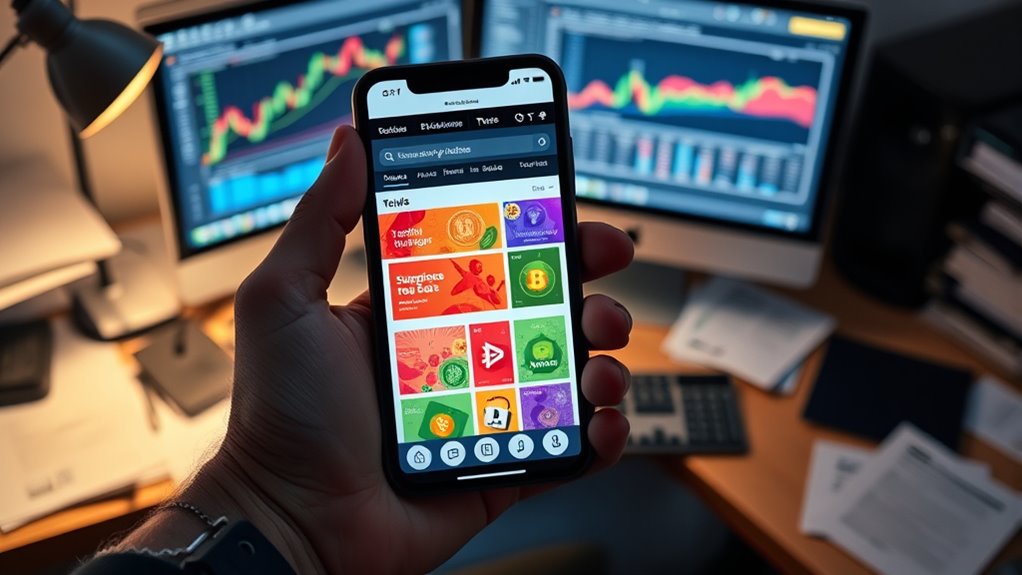To avoid rug pulls, watch for red flags like sudden liquidity drains or pools that are easy to manipulate, which can mislead you about a project’s stability. Skim over vague whitepapers filled with buzzwords and lack clear details or verifiable team info. Also, be cautious if liquidity is concentrated in a few wallets or if promises of high returns lack solid backing. Stay sharp—keeping an eye out for these signs can save your investments before it’s too late.
Key Takeaways
- Check for sudden liquidity pool drain risks and concentrated wallets that can manipulate or exit quickly.
- Scrutinize whitepapers for vagueness, lack of technical details, and unrealistic promises.
- Verify team backgrounds and seek open-source code to confirm project transparency.
- Be cautious of projects with rapidly changing or unverifiable project details and roadmaps.
- Prioritize tokens with locked liquidity and a history of active development to reduce scam risk.

Rug pulls are among the most common scams in the cryptocurrency world, and they can leave investors devastated. When you’re exploring new tokens, it’s essential to do your homework before committing your funds. One of the key areas to scrutinize is liquidity pools. These pools are where tokens are pooled together for trading on decentralized exchanges, and scam tokens often manipulate these pools to give a false sense of legitimacy. If you notice that a project’s liquidity pool is artificially inflated or if the liquidity appears to be drained quickly after the token launch, it’s a major red flag. Scam projects often create fake or misleading liquidity pools to lure investors in, only to pull the liquidity once enough funds are gathered. Always check the actual liquidity and how it’s distributed. If the liquidity pool is concentrated with a few wallets or if the liquidity is locked for a very short period, proceed with caution. Locked liquidity is preferable because it prevents the developers from pulling the rug suddenly, but even then, you should verify how and where the liquidity is locked.
Another vital step in avoiding scam tokens is conducting a thorough whitepaper analysis. A legitimate project will have a clear, detailed whitepaper outlining its goals, technology, tokenomics, and development roadmap. If the whitepaper is vague, poorly written, or full of buzzwords without substance, it’s a warning sign. Scam tokens often release superficial whitepapers to give the illusion of legitimacy. Look for transparency—does the whitepaper explain how the project plans to generate value? Are the team members identified with verifiable backgrounds? Do they lay out a realistic roadmap? If these elements are missing or appear suspicious, it’s best to steer clear. Be wary of projects that promise extraordinary returns with little explanation or those that rely heavily on hype without providing concrete technical details. Additionally, understanding the technology stack behind a project can help verify its legitimacy, as reputable projects usually have open-source code repositories and active development communities.
Combining a careful review of liquidity pools with diligent whitepaper analysis helps you catch red flags early. If a project’s liquidity is suspiciously easy to manipulate or if the whitepaper is lacking in specifics, it’s wise to avoid investing. Remember, scammers rely on your inattention and haste. Take your time to research, verify all claims, and don’t let hype or promises cloud your judgment. Being cautious now can save you from losing significant sums later. Always prioritize transparency and verifiable data before jumping into any new token, especially in the volatile world of DeFi.
Frequently Asked Questions
How Can I Verify a Token’s Legitimacy Before Investing?
To verify a token’s legitimacy before investing, start with a thorough whitepaper analysis to understand its purpose and technology. Check the developer background—research their experience and past projects to guarantee credibility. Be wary of vague descriptions or anonymous developers. Use reputable sources to cross-verify information, and look for transparent communication. This proactive approach helps you spot potential red flags and make informed investment decisions.
What Are Common Signs of a Scam Token?
When evaluating a scam token, look for red flags like vague whitepaper analysis or exaggerated influencer endorsements. If the whitepaper lacks detail or seems rushed, it’s a warning sign. Be cautious if influencers promote it without transparency or proven credentials. These signs suggest the token might be a scam, so do thorough research, verify sources, and avoid impulsive investments to protect your funds.
Is a High Token Price Always a Red Flag?
A high token price isn’t always a red flag, but it can sometimes indicate price manipulation or inflated token valuation. You should look beyond the price and assess the token’s fundamentals, like its market cap, circulating supply, and community activity. If the price seems artificially high without solid backing, it’s wise to be cautious. Remember, scammers often use high prices to lure investors into thinking it’s more valuable than it really is.
How Does Liquidity Affect the Safety of a Token?
Did you know that over 70% of scam tokens fail due to poor liquidity? Liquidity affects your safety because it determines how easily you can buy or sell tokens without causing price swings. Check the liquidity pools and market depth—deep pools mean more stability and less risk of sudden crashes. If liquidity is low, you might find it hard to exit your position, increasing your chances of losses.
Can Community Feedback Predict Potential Rug Pulls?
Community feedback can provide early warning signs of potential rug pulls, especially when you pay attention to social media and influencer endorsements. If multiple community members express doubts or report suspicious activity, it’s a red flag. Be cautious of overly positive comments or endorsements from influencers that seem too good to be true. Engaging with genuine community discussions helps you spot warning signs and avoid scams before investing.
Conclusion
By learning to spot these red flags, you can protect yourself from scam tokens and avoid costly rug pulls. It might seem overwhelming at first, but with a little research and vigilance, you’ll become more confident in your investment choices. Remember, taking the time to check for warning signs isn’t just about avoiding scams—it’s about making smarter, safer decisions that keep your crypto journey enjoyable and secure. Stay cautious, stay informed, and invest wisely!









